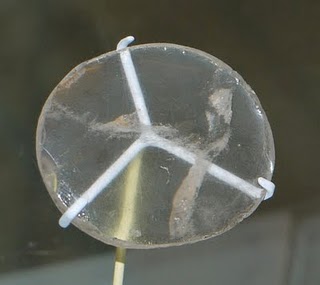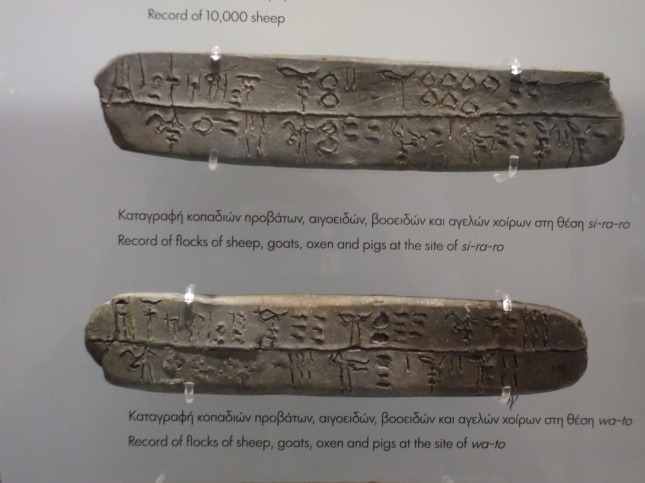The ancient Linear B tablets which I have been working on are so very small, that I often wondered how the Minoan scribes were able to see to write them, let alone read each others scripts, until I came across this wonderful article about Ancient Lenses.:
To date, the earliest lenses identified in context are from the IV/V Dynasties of Egypt, dating back to about 4,500 years ago (e.g; the superb ‘Le Scribe Accroupi’ and ‘ the Kai ‘ in the Louvre; added fine examples are located in the Cairo Museum) Latter examples have been found in Knossos (Minoan Heraklion Museum); ca 3,500 years ago). Another, possibly 5th century BC, lens was found in a sacred cave on Mount Ida Crete. It was more powerful and of better quality than the Nimrud lens which is the oldest lens in the world now in the British Museum.
The Nimrud Lens The oldest Lens in the world.
Also Roman writers Pliny and Seneca refer to a lens used by an engraver in Pompeii. So perhaps the ancients knew more about lenses than we give them credit for (it only takes two lenses together in a tube and you have a telescope).
These ancient lenses generally magnify about l.5 or 2 times. Heinrich Schliemann the 19th century discoverer of Troy, excavated 48 rock crystal lenses at Troy. This is one of the largest hoards of ancient lenses ever found. These were unfortunately lost for many decades because they were with the missing Trojan gold hoard which disappeared from the Berlin Museum at the end of the Second World War. In recent years the Russians have admitted that the Red Army stole the gold and it is all in Moscow today. The 48 lenses are with these gold artifacts.
Heinrich Schliemann. Discoverer of Troy.
Another large number of crystal lenses exist in Crete, mostly found at Knossos. And yet another hoard exists at Ephesus in Turkey, though those ones are very unusual because they are concave lenses used to correct myopia (short sightedness), some shrinking images by as much as 75%
Most ancient lenses are convex and were used to magnify. At Carthage there are fourteen glass lenses and two rock crystal stored in a draw in the museum; they have apparently not been displayed as yet that I know of.
Egypt too has examples one pair of glass lenses was excavated from the wrappings of a mummy and obviously were used as spectacles except that loops around the ears for modern style spectacles seem not to have been invented in ancient times. So these may have had some kind of nose loop or may have been held as a lorgnette. The oldest evidence of a sophisticated optical capability so far found goes back as far as 3300 BC. An ivory knife handle was excavated in the 1990s from a pre-dynastic grave of that date at Abydos in Egypt. It belonged to a king and bears microscopic carvings which could only have been made with, and can only be seen with ,a magnifying glass.
So coming back to the Linear B ancient Minoan script writers, if in fact they did use lenses, I say IF because we don’t know for sure, how troublesome this would be trying to hold the lenses on while writing. Were these lenses held on by some sort of nose loop or held as a lorgnette.
Below are a few examples of the tablets with which the scribes had to write as much information that they could get on them. What a task they had, and what a great task professional linguists and myself are having learning the history which is written on them.
As you can see the ancient Minoan scribes had a limited amount of room to record such a huge amount of sheep, goats ,oxen and pigs.
Even smaller Linear B Tablets.





Linnea Tanner
August 18, 2015 at 5:28 am
Reblogged this on Apollo's Raven and commented:
Reblog of Interesting Article on Ritaroberts Blog regarding Ancient Lenses: Optical Lenses at Knossos.
Enjoy!
LikeLike
vallance22
August 20, 2015 at 9:57 pm
Splendid post, Rita! So glad you went ahead with this! I am of course reblogging it! I shall get to your military tablet you sent me this weekend. PS I hope you got my message about my new e-mail address. I simply had to get rid of Gmail. Such a hassle!
Best
Richard
LikeLike
vallance22
August 20, 2015 at 9:59 pm
Reblogged this on Linear B, Knossos & Mycenae and commented:
This is an excellent post about the use of lenses in the ancient world! Yes, they had them! The ancients were amazing. So many things we thought were discovered so much later in history date to ancient times! Amazing! Richard
LikeLike
cav12
August 23, 2015 at 6:26 am
What a fantastic find. I think we underestimate the ancient cultures.
LikeLike
ritaroberts
August 23, 2015 at 7:02 am
Thanks for your nice comment. Yes ! up until now I agree, but since learning about the Minoan culture and their short hand writing on the clay tablets I am amazed at their many skills.
LikeLike
Kathleen_Vail
May 30, 2017 at 1:54 am
Finally an answer as to how the Minoans could have achieved such amazing intricacy on the tiny gemstone seals and gold signet rings! Thanks so much for this, Rita!
LikeLike
ritaroberts
May 30, 2017 at 7:37 am
Hi Kathleen, Yes it never ceases to amaze me just what the ancient people achieved. And what about that fantastic discovery of the Antikathera Mechanism. And with modern technology I am sure there is much more to be discovered. Thanks for visiting my blog and your nice comment.
LikeLike
normci
May 11, 2020 at 9:11 am
Hi Rita! You have a very interesting blog. – I was googling to find out more on the ‘concave lenses’ found at Ephesus. I had read about the possible use of these to correct myopia (which may be true); however, when I was young (‘when there were wolves in Wales’), I made a refracting telescope, using a convex lense for the object lense and a concave lense for the eye-piece. The concave lense allowed the image to remain upright. – Ideal for terrestrial observations. It seems to me that if the ancients were skilled enough to make lenses to correct for myopia, they most likely understood how to make a simple telescope as I described and that such lenses could have been used for this purpose.
I wonder: Is there any hard evidence that might suggest telescopes were in use in ancient times?
LikeLike
ritaroberts
May 11, 2020 at 12:14 pm
Your home made telescope sounds interesting Because of modern technology, the school of thought is that our ancestors were far more intelligent than previously thought, so you never know.
LikeLiked by 1 person
ritaroberts
May 11, 2020 at 3:52 pm
Reblogged this on Ritaroberts's Blog.
LikeLike
Maria Lloyd
July 31, 2020 at 2:16 pm
Hi Rita,
I really like the wide range of posts on your blog. I’ve certainly learned a few things!
If you have time, I’d be very interested in having your input on a chapter that I am working on for a forthcoming publication. It is a chapter on blogging for an edited volume which explores how the ancient world is represented through new media.
I’m looking for ancient world bloggers who are able to complete a survey, which will take less than 5 minutes to complete.
If you are able to help, please let me know.
Many thanks.
LikeLike
ritaroberts
August 3, 2020 at 6:22 pm
Hello Marie, Please let me know what the survey is and I would be willing to help if I can.
LikeLike
Maria Lloyd
August 4, 2020 at 7:36 am
Hi Rita,
Thank you for your reply. Your help would be much appreciated!
My chapter is for an edited volume, which explores how the ancient world is represented through new media, such as blogs, digital magazines, and digital videos. The purpose of my chapter is to explore the benefits and drawbacks of blogging and blogs- both for authors and audiences- as a way to make the ancient world more accessible in the modern, digital age.
As mentioned, I am looking for bloggers (who include the ancient world in their blogs) to help me by completing a survey. It’s short and quick to complete. The survey consists of 16 questions to complete, including multiple choice, checkboxes, and open answers. It should no more than 5 minutes to complete.
Here is the google forms link:
https://forms.gle/FfiPotz9PHALaoEAA
Papers for the volume will be submitted in January. I will let all participants know when I have review and publication dates confirmed.
Also, if you have any questions about blogging which you think my project can help you with please don’t hesitate to let me know.
Many thanks.
Best wishes,
Maria
LikeLike